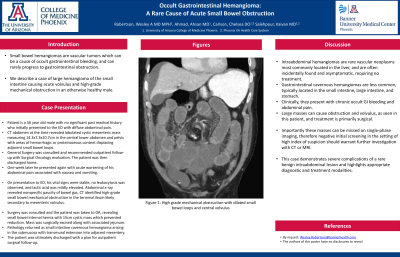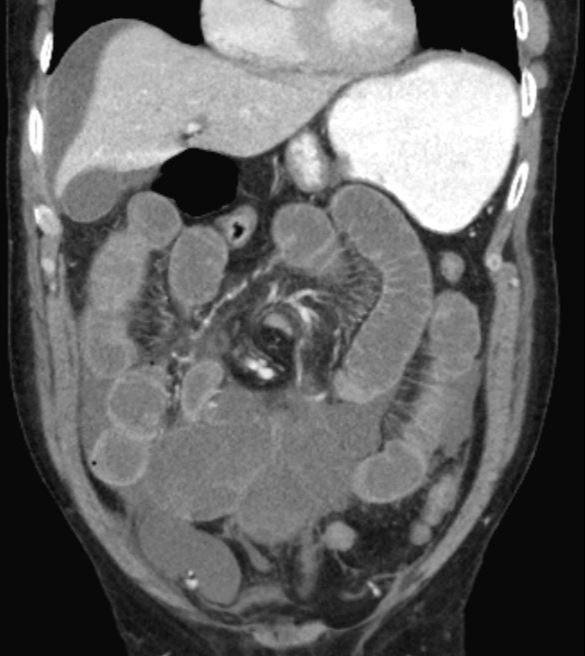Sunday Poster Session
Category: Small Intestine
P1263 - Occult Gastrointestinal Hemangioma: A Rare Cause of Acute Small Bowel Obstruction
Sunday, October 22, 2023
3:30 PM - 7:00 PM PT
Location: Exhibit Hall

Has Audio

Wesley A. Robertson, MD, MPH, MPA
University of Arizona College of Medicine
Phoenix, AZ
Presenting Author(s)
Wesley A.. Robertson, MD, MPH, MPA1, Ahsan Ahmad, MD1, Chelsea Carlson, DO2, Kaivan Salehpour, MD3
1University of Arizona College of Medicine, Phoenix, AZ; 2Phoenix VA Health Care System, Phoenix, AZ; 3Phoenix VA Health Care System, Pheonix, AZ
Introduction: Small bowel hemangiomas are vascular tumors which can be a cause of occult gastrointestinal bleeding, and can rarely progress to gastrointestinal obstruction. We describe a case of large hemangioma of the small intestine causing acute volvulus and high-grade mechanical obstruction in an otherwise healthy male.
Case Description/Methods: Patient is a 56 year old male with no significant past medical history who initially presented to the ED with diffuse abdominal pain. CT abdomen at the time revealed lobulated cystic mesenteric mass measuring 14.3x7.3x10.7cm in the central lower abdomen and pelvis with areas of hemorrhagic or proteinaceous content displacing adjacent small bowel loops. General Surgery was consulted and recommended outpatient follow-up with Surgical Oncology evaluation. The patient was then discharged home. One week later he presented again with acute worsening of his abdominal pain associated with nausea and vomiting.
On presentation to ED, his vital signs were stable, no leukocytosis was observed, and lactic acid was mildly elevated. Abdominal x-ray revealed nonspecific paucity of bowel gas, CT identified high-grade small bowel mechanical obstruction in the terminal ileum likely secondary to mesenteric volvulus. Surgery was consulted and the patient was taken to OR, revealing small bowel internal hernia with 15cm cystic mass which prevented reduction. Mass was surgically excised along with associated jejunum. Pathology returned as small intestine cavernous hemangioma arising in the submucosa with transmural extension into adjacent mesentery. The patient was ultimately discharged with a plan for outpatient surgical follow-up.
Discussion: Intraabdominal hemangiomas are rare vascular neoplasms most commonly located in the liver, and are often incidentally found and asymptomatic, requiring no treatment. Gastrointestinal cavernous hemangiomas are less common, typically located in the small intestine, large intestine, and stomach. Clinically, they present with chronic occult GI bleeding and abdominal pain. Large masses can cause obstruction and volvulus, as seen in this patient, and treatment is primarily surgical.
Importantly these masses can be missed on single-phase imaging, therefore negative initial screening in the setting of high index of suspicion should warrant further investigation with CT or MRI. This case demonstrates severe complications of a rare benign intraabdominal lesion and highlights appropriate diagnostic and treatment modalities.

Disclosures:
Wesley A.. Robertson, MD, MPH, MPA1, Ahsan Ahmad, MD1, Chelsea Carlson, DO2, Kaivan Salehpour, MD3. P1263 - Occult Gastrointestinal Hemangioma: A Rare Cause of Acute Small Bowel Obstruction, ACG 2023 Annual Scientific Meeting Abstracts. Vancouver, BC, Canada: American College of Gastroenterology.
1University of Arizona College of Medicine, Phoenix, AZ; 2Phoenix VA Health Care System, Phoenix, AZ; 3Phoenix VA Health Care System, Pheonix, AZ
Introduction: Small bowel hemangiomas are vascular tumors which can be a cause of occult gastrointestinal bleeding, and can rarely progress to gastrointestinal obstruction. We describe a case of large hemangioma of the small intestine causing acute volvulus and high-grade mechanical obstruction in an otherwise healthy male.
Case Description/Methods: Patient is a 56 year old male with no significant past medical history who initially presented to the ED with diffuse abdominal pain. CT abdomen at the time revealed lobulated cystic mesenteric mass measuring 14.3x7.3x10.7cm in the central lower abdomen and pelvis with areas of hemorrhagic or proteinaceous content displacing adjacent small bowel loops. General Surgery was consulted and recommended outpatient follow-up with Surgical Oncology evaluation. The patient was then discharged home. One week later he presented again with acute worsening of his abdominal pain associated with nausea and vomiting.
On presentation to ED, his vital signs were stable, no leukocytosis was observed, and lactic acid was mildly elevated. Abdominal x-ray revealed nonspecific paucity of bowel gas, CT identified high-grade small bowel mechanical obstruction in the terminal ileum likely secondary to mesenteric volvulus. Surgery was consulted and the patient was taken to OR, revealing small bowel internal hernia with 15cm cystic mass which prevented reduction. Mass was surgically excised along with associated jejunum. Pathology returned as small intestine cavernous hemangioma arising in the submucosa with transmural extension into adjacent mesentery. The patient was ultimately discharged with a plan for outpatient surgical follow-up.
Discussion: Intraabdominal hemangiomas are rare vascular neoplasms most commonly located in the liver, and are often incidentally found and asymptomatic, requiring no treatment. Gastrointestinal cavernous hemangiomas are less common, typically located in the small intestine, large intestine, and stomach. Clinically, they present with chronic occult GI bleeding and abdominal pain. Large masses can cause obstruction and volvulus, as seen in this patient, and treatment is primarily surgical.
Importantly these masses can be missed on single-phase imaging, therefore negative initial screening in the setting of high index of suspicion should warrant further investigation with CT or MRI. This case demonstrates severe complications of a rare benign intraabdominal lesion and highlights appropriate diagnostic and treatment modalities.

Figure: Figure 1: High grade mechanical obstruction with dilated small bowel loops and central volvulus
Disclosures:
Wesley Robertson indicated no relevant financial relationships.
Ahsan Ahmad indicated no relevant financial relationships.
Chelsea Carlson indicated no relevant financial relationships.
Kaivan Salehpour indicated no relevant financial relationships.
Wesley A.. Robertson, MD, MPH, MPA1, Ahsan Ahmad, MD1, Chelsea Carlson, DO2, Kaivan Salehpour, MD3. P1263 - Occult Gastrointestinal Hemangioma: A Rare Cause of Acute Small Bowel Obstruction, ACG 2023 Annual Scientific Meeting Abstracts. Vancouver, BC, Canada: American College of Gastroenterology.
